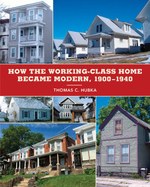Daily Dose of Architecture: Focusing on middle-class American houses.
 How the Working Class Became Modern is clearly a history, and a very nuanced one at that, but one aspect of it that departs from other histories — residential or otherwise — is the abundance of original drawings. Done by the author with Erik Larson, the drawings in the book range from bubble diagrams and charts to elevations and floor plans. The skilled use of lineweights makes them all easy to read and beautiful on the page. Of course, they are not eye candy; they are aligned with the author's desire to trace the changes in middle-class housing a century ago, changes best seen in the enlargement of floor plans and the arrangement of their rooms. Architects, historians, housing advocates, and other people interested in the houses most Americans live in should find much to like in How the Working Class Became Modern.
How the Working Class Became Modern is clearly a history, and a very nuanced one at that, but one aspect of it that departs from other histories — residential or otherwise — is the abundance of original drawings. Done by the author with Erik Larson, the drawings in the book range from bubble diagrams and charts to elevations and floor plans. The skilled use of lineweights makes them all easy to read and beautiful on the page. Of course, they are not eye candy; they are aligned with the author's desire to trace the changes in middle-class housing a century ago, changes best seen in the enlargement of floor plans and the arrangement of their rooms. Architects, historians, housing advocates, and other people interested in the houses most Americans live in should find much to like in How the Working Class Became Modern.
Article in Daily Dose of Architecture.